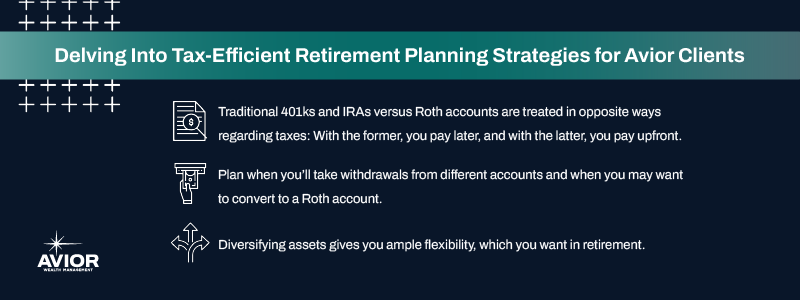Delving Into Tax-Efficient Retirement Planning Strategies for Avior Clients
By Roddy Warren, CFP®️, Wealth Advisor
Avior financial advisors guide clients on the right steps for tax-optimized retirement. Find out the strategies they advise implementing, like diversification.

Achieving a comfortable, secure retirement is one of most people’s biggest financial goals. Unfortunately, complex tax implications can get in the way.
With the right tax planning strategies that help you optimize your retirement income and minimize taxes, though, you’re on your way to creating a successful plan.
Being proactive about retirement planning is important at any age. After all, you’re planning for the rest of your life. Preparing for it now ensures you’re setting up your retirement years for freedom and comfortability, including aligning your unique goals with your financial plan.
Avior guides its clients to an understanding that retirement is all about cash flow, and specifically how they supply their income needs in a tax-efficient way. This guide walks through key considerations for tax planning, including types of accounts, strategies, and tax-specific considerations.
How to leverage tax-advantaged retirement accounts
Avior advisors will ensure clients fully understand each type of retirement account and how they fit into their overall plan before creating solutions. Here’s an overview of common retirement accounts:
- Pensions: Pensions are 100% taxable, so there’s not much you can do to get around that. However, you can wait to claim the income later if you don’t want to recognize it in a particular year.
- Social Security: Social Security can be taxed at 85%, but the amount that’s taxed depends on your total income. Strategizing around investments or claiming a pension later can help. Avior helps clients think about timing around when they retire and when to make investment transactions to minimize the amount of their Social Security benefit that is included in taxable income.
- Traditional IRAs and 401ks: These are very similar to one another in tax treatment. They have deferred income, so you contribute now, avoiding the tax and getting a tax deduction. But later in retirement, you pay tax on your withdrawals. The account will grow over time as you invest, but every dollar that comes out will be taxed.
- Roth accounts: For Roth 401ks or IRAs, you pay zero tax when you get withdrawals in retirement because you pay it when you contribute (now). You thus want to contribute in your low tax bracket years, so these are often advised when clients are young.
Some wealth management clients opt for a balance of these different tax treatments. Strategies should always be revisited and may change over time as you near retirement, your income changes, or your goals change.
So, what about making withdrawals?
Implementing tax-efficient withdrawal strategies
A big part of any retirement strategy includes when or how withdrawals will be made. Here are a few key strategies to remember:
1. The tax-bracket approach
The tax-bracket approach, touched on above, is when you consider the time in which you’ll have the lowest tax bracket so you can recognize income in those years. Even if it’s later in life, contributing to a Roth account is a good idea if you still think you’ll be in a higher tax bracket later on.
2. Roth conversions
A Roth conversion can be smart, wherein you take your traditional account and convert it to a Roth. This is helpful if you think tax laws will change – and historically, tax rates always go up. You may also consider this if you have distribution requirements or deferred compensation coming up that will force you into a higher income tax bracket.
One strategy Avior implements with clients is something called the Roth conversion ladder. The “ladder” refers to a five-year waiting period for each conversion. If you contribute to a Roth and make a withdrawal three years later, for instance, you’ll be taxed on any gains, so you lose the tax-free growth benefit (and pay a 10% penalty if you are less than age 59 ½). It’s not advantageous to withdraw within those first five years.
There are also considerations to make for your heirs. If someone inherits your IRA, they must liquidate the account within 10 years and pay taxes on the income. With a Roth IRA, the 10-year distribution rule doesn’t force them to pay taxes within that 10-year window, so it can be a good idea to do a Roth conversion when thinking about impacts on heirs.
3. The bucket approach
Avior advisors prefer using the bucket approach, where you invest money in different buckets for different periods. For example, the short-term bucket should be for the next few years of income needs and be highly liquid, like cash, money market accounts, or short-term bonds. The next bucket, which should be for the next five years or so, could include short to intermediate-term bonds. Then, the long-term bucket brings in stocks.
These buckets mean that if there’s a market downturn, you already have what you need now set aside. As bucket one depletes, you move bucket two to bucket one, then bucket three to bucket two, and so on. You are protecting yourself with different types of investments over time this way.
4. Capital gains
Another strategy factors in capital gains. In a low-income year, there may be an opportunity to take capital gains with no tax implications.
The capital gains tax rate is normally 15% or 20%. However, if you’re in the 12% or lower income tax brackets, you pay zero taxes on capital gains. This is a huge benefit for a low-income year. These come in limited windows, so take advantage of them.
Diversification is key. Learn about gaining flexibility next.
Diversification for tax efficiency
An optimal retirement strategy includes a lot of flexibility. For example, instead of being forced to take out thousands of dollars to pay taxes when you want a new car, you can use your non-retirement account or Roth account to fill in those cash-flow gaps for bigger purchases. You can minimize taxes on non-retirement account withdrawals and do not have to pay any tax for Roth account withdrawals.
If you’re in poor health or don’t need the money right now, you could become more aggressive with your investment strategy in your non-retirement accounts and take withdrawals from your other accounts. When you pass away, you get a step up in basis in the non-retirement accounts. All the growth goes to your heirs, helping them get established on the right foot. And, they don’t have to pay taxes on it.
It also depends on your legacy intentions. It’s good to have flexibility in retirement to have different types of withdrawals. If you didn’t have any type of non-retirement account, you wouldn’t have quite as much flexibility to strategize around taxes.
Annuities are also worth considering. They’re customizable, and you can guarantee money to heirs after you pass away. The most common type is a life annuity, which acts as longevity insurance. Instead of risking outliving your assets and relying on Medicaid or your kids to support you, you pass on the risk to the insurance company. You put in X amount, and the insurance company pays you for the rest of your life, even if you live longer than you think you will.
Another benefit of annuities is that you don’t have to worry about calculating distribution requirements from your IRA since contributing to a life annuity takes that off the table.
These strategies will put you in a great position to grow your wealth and minimize taxes for the retirement you’ve been planning.
Avior’s commitment to personalized financial guidance
Avior recognizes that clients want to minimize their tax burden as much as possible in retirement. Tax-efficient retirement planning and wealth management are where Avior shines.
Retirement planning is complex with all the moving parts and overlap. For example, a client may think that one decision regarding Social Security makes sense, but then it could impact another aspect of their plan negatively. It’s extremely important to see how it all fits together clearly and cohesively in a comprehensive financial plan, and how tax-efficient strategies can benefit your retirement.
Get in touch with Avior today to get started with retirement planning.
Byline for Roddy: Roddy Warren, CFP®️, is a wealth advisor with Avior Wealth Management. He received his BBA in Personal Financial Planning from Angelo State University with high honors and his MS in Personal Financial Planning from Texas Tech University. Roddy has worked in the financial planning industry for 10 years where he’s gravitated toward retirement planning, providing value for clients by crafting retirement plans with tax-efficient strategies.
Disclaimer: Nothing contained herein should be construed as legal or tax advice. Avior and our Advisors will work with your attorney and/or tax professional to assist with your legal and tax strategies. Please consult your attorney or tax professional with specific legal and/or tax questions.
No Comments
Sorry, the comment form is closed at this time.




